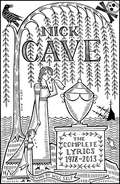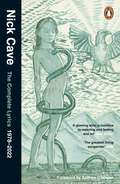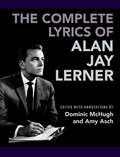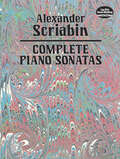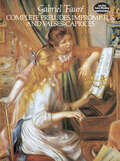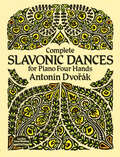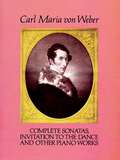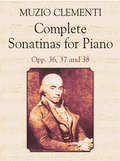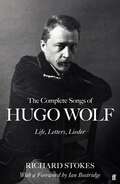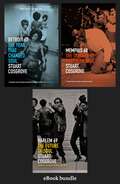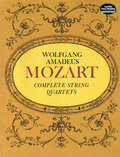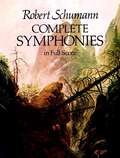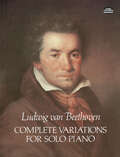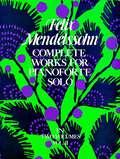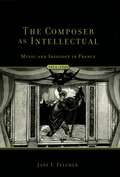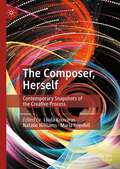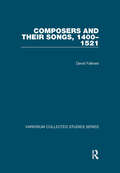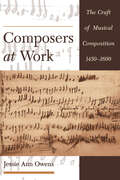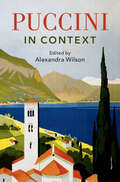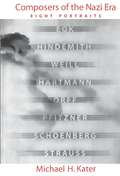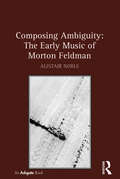- Table View
- List View
The Complete Lyrics: 1978-2013
by Nick CaveThe complete collection of Nick Cave lyrics spanning his entire career, from 1978 until 2013, revised and updated by the cult rock star'He is an Australian artist like Sidney Nolan is an Australian artist - beyond comparison, beyond genre, beyond dispute' - from Nick Cave's induction into the Australian Hall of FameThis complete collection of Nick Cave's lyrics spans his entire career, from his writing for The Birthday Party through the highly acclaimed Murder Ballads and The Boatman's Call to recent work with Grinderman and his 2013 album, Push the Sky Away. Brought together in one volume, these lyrics make up one of the most outstanding achievements of contemporary music.Switching between the cynical and the sanguine, the defeated and the defiant, Nick Cave deals in love, war, beauty, children, romance, rejection, Pethedine, poetry, pants, money, flowers and so much more ...From the bestselling author of And the Ass Saw the Angel and The Death of Bunny Munroe this definitive collection will be adored by Nick Cave fans everywhere.'His lyrics deal with passion on the edge, and are peopled with mad bayou preachers, black-hearted lovers and killers. His language is rich, poetic, apocalyptic' Guardian'Richly poetic creations which live a second life on the page ... Essential reading' VoxNick Cave was born in Australia in 1957. He moved to London with his band The Birthday Party in 1990 and four years later he formed The Bad Seeds, with whom he has made 15 studio albums. In recent years he has made two albums with his other band, Grinderman. In 1999 he curated and directed the Meltdown Festival at London's South Bank Centre. He has also written the soundtrack for a number of successful films including The Assassination of Jesse James, Lawless and The Proposition. His novel And the Ass Saw the Angel was an international bestseller, Time Out's Book of the Year, and was reissued in the Penguin Essential series. His second novel The Death of Bunny Monroe was published in 2009. He lives in Brighton with his wife and two children.
The Complete Lyrics: 1978–2022
by Nick CaveThe complete lyrics from cultural icon and bestselling author Nick Cave, spanning his entire career to date, with a new foreword by Andrew O'HaganFrom Nick Cave's writing for The Birthday Party, through highly acclaimed albums like Murder Ballads, Henry's Dream, DIG, LAZARUS, DIG!!! and Ghosteen, this is a must-have book for all fans of the dark, the beautiful and the defiant - for all fans of the songs of Nick Cave.'The greatest living songwriter' NME'A glowing wire, a mainline to meaning ad feeling and art' New Yorker'Nick Cave is a true lyrical master. He can conjure empathy and hope out of thin air, light out of darkness' Cillian Murphy'His lyrics - so rich in the toils of love, so committed to memory and everlasting presence - are the best-made of his generation' Andrew O'Hagan'A poetic craftsman' Will Self'Alternative rock legend' Billboard'Cave's genius rings loud and clear' Evening StandardCover art by Aleksandra Waliszewska
The Complete Lyrics of Alan Jay Lerner
by Dominic McHugh and Amy AschAlan Jay Lerner wrote the lyrics for some of the most beloved musicals in Broadway and Hollywood history. Most notably, with composer Frederick Loewe he created enduring hits such as My Fair Lady, Gigi, Camelot, and Brigadoon. In The Complete Lyrics of Alan Jay Lerner, editors and annotators Dominic McHugh and Amy Asch bring all of Lerner's lyrics together for the first time, including numerous draft or alternate versions and songs cut from the shows. Compiled from dozens of archival collections, this invaluable resource and authoritative reference includes both Lerner's classic works and numerous discoveries, including his unproduced MGM movie Huckleberry Finn, selections from his college musicals, and lyrics from three different versions of Paint Your Wagon. This collection also includes extensive material from Lerner's two most ambitious musicals: Love Life, to music by Kurt Weill, and 1600 Pennsylvania Avenue, which Lerner wrote with Leonard Bernstein.
The Complete Lyrics of Alan Jay Lerner
Alan Jay Lerner wrote the lyrics for some of the most beloved musicals in Broadway and Hollywood history. Most notably, with composer Frederick Loewe he created enduring hits such as My Fair Lady, Gigi, Camelot, and Brigadoon. In The Complete Lyrics of Alan Jay Lerner, editors and annotators Dominic McHugh and Amy Asch bring all of Lerner's lyrics together for the first time, including numerous draft or alternate versions and songs cut from the shows. Compiled from dozens of archival collections, this invaluable resource and authoritative reference includes both Lerner's classic works and numerous discoveries, including his unproduced MGM movie Huckleberry Finn, selections from his college musicals, and lyrics from three different versions of Paint Your Wagon. This collection also includes extensive material from Lerner's two most ambitious musicals: Love Life, to music by Kurt Weill, and 1600 Pennsylvania Avenue, which Lerner wrote with Leonard Bernstein.
Complete Piano Sonatas
by Alexander ScriabinLike Chopin, Scriabin made the piano the focus of his art. Among the supreme achievements of that art are the ten sonatas he composed between 1892 and 1913, works that abundantly display both his technical virtuosity and the exhilarating emotional gamut he ranged with such individuality.All ten of Scriabin's sonatas are reprinted here from the authoritative Russian edition published in 1964. The first four reveal the influences of the pianism of Chopin and Liszt. The subsequent sonatas richly display Scriabin's emerging impressionist techniques and his deep attraction to mysticism, which progressively conjured a more and more ethereal framework of sound, now brooding and introspective, now rhapsodic and exultant.In both their technical requirements and their emotional demands, these brilliant works will offer pianists a deeply satisfying challenge. Nonpianists will also enjoy this finely made edition, with which they may follow, music in hand, the growing number of loved and recorded performances of these masterpieces.
Complete Preludes, Impromptus and Valses-Caprices
by Gabriel FauréGabriel Fauré (1845-1924) enriched the literature of the piano with freshly melodic, elegantly wrought compositions that embody the aristocratic qualities of the French tradition. This superbly produced volume brings together in one authoritative playing edition one of the most important segments of his works for piano: all of his nine Preludes, five Impromptus, and four Valses-Caprices.Each of these distinctive compositions, so often heard today in concert and recital halls around the world and frequently recorded by leading pianists, reveal Fauré's lyrical melodic gifts and innovative harmonies and the classical qualities of clarity, balance, and serenity characteristic of his work.Pianists of intermediate and advanced skills will find in these richly varied compositions -- unavailable elsewhere in one volume -- a unique opportunity to explore the elegant artistry of one of the most gifted and influential composers of the French school. Music lovers at every level of accomplishment will discover in this well-made, yet inexpensive edition a most satisfying way to savor fine music: to follow phrase by phrase, music in hand, a live or recorded performance.
Complete Slavonic Dances for Piano Four Hands
by Antonin DvorákThe two series of piano duets combined in this volume are among Dvořák's most famous compositions and among the most performed works in the piano four hands repertoire. The composer intended them as artistic stylizations of typical Slavonic dances such as the furiant, the dumka, the polka, the skočná, the odzemek, and the kolo.The first series of eight dances, Opus 46 (1878), is full of joy and vitality. The second set of eight dances, Opus 72 (1886), is slightly more somber and meditative. Both series will delight pianists with their exciting rhythms and fresh, highly individual invention. They are reprinted here from the authoritative Czechoslovakian editions of Dvořák's complete works.
Complete Sonatas, Invitation to the Dance and Other Piano Works
by Carl Maria WeberA virtuoso of the piano and a pioneer of musical Romanticism, Carl Maria von Wolfe (1786-1926) wrote piano music of elegance and grandeur enhanced with bravura technical effects that profoundly influenced later 19th-century piano music. This volume presents virtually all Weber's works for piano solo: the four piano sonatas -- Opus 24 in C Major (1812), Opus 39 in A-flat Minor (1816), Opus 49 in D Minor (1816), and Opus 70 in E Minor (1822) -- considered the core of his output; his most popular piano composition, Invitation to the Dance, a waltz later orchestrated by Berlioz and used for the celebrated ballet Le Spectre de la Rose; eight lively and engaging sets of variations; and the dazzling Momento Capriccioso, Grande Polonaise, Rondo Brillante, and Polacca Brillante. Pianists will enjoy exploring this richly varied collection of piano masterworks, reprinted from the authoritative edition published by C. F. Peters of Leipzig.
Complete Sonatinas for Piano: Opp. 36, 37 and 38 (Dover Music for Piano)
by Muzio ClementiOften regarded as the father of piano technique, Clementi was the first composer to achieve the fully matured piano sonata of the late Classic period. This edition includes all 12 of the splendid miniature sonatas — so-called sonatinas — that comprise Clementi's Opp. 36, 37, and 38. Musicians and music lovers will find in this authoritative edition a rich selection of music by an innovative and influential composer.
The Complete Songs of Hugo Wolf: Life, Letters, Lieder
by Richard StokesThe Complete Songs of Hugo Wolf gathers together for the first time every poem Wolf set to music. Alongside the original German texts are translations by leading Lieder expert Richard Stokes, who also provides illuminating commentary. The 36 poets set by Wolf are each given their own chapter: a brief essay on the poet is followed by a note on Wolf's connection with the writer, extracts from letters that throw light on the Songs and convey his mood at the time of composition, and the texts and translations. Short biographies of all Wolf's correspondents flesh out the extraordinary life of this genius. This will be an indispensable volume for all lovers of Lieder.
The Complete Soul Trilogy: eBook Bundle
by Stuart CosgroveSpanning three different cities across the United States, Stuart Cosgrove’s bestselling Soul Trilogy blends history, culture and music to paint a vivid picture of social change through the last years of the 1960s.Strap in for a journey through urban riots, escalating war in Vietnam, police corruption, the assassination of Martin Luther King, the rise of musical pioneers such as Aretha Franklin, Elvis Presley and Johnny Cash, the arrest of the Black Panther members and their controversial trials, and much, much more. Award-winning and critically acclaimed, these are books that no soul music enthusiast should be without.‘Cosgrove's lucid, entertaining prose is laden with detail, but never at the expense of the wider narrative’ – Clash MagazineTitles included in this bundle are:Detroit 67Memphis 68Harlem 69
Complete String Quartets
by Wolfgang Amadeus MozartThis single volume contains all the string quartets of Mozart: the little-known early quartets in an Italianate manner composed between 1770 and 1773: the six quartets dedicated to Franz Josef Haydn (1782-85); the D Major Quartet (K.499) composed in 1786; and the last three quartets (1789-90) written for the King of Prussia. In addition to the 23 string quartets, the volume contains an alternate slow movement to the G Major Quartet, K. 156.The music is photographically reprinted from the Breitkopf & Härtel printed score, still considered the standard, authoritative edition for the Mozart quartets.Noteheads in this edition have been reproduced in a size large enough to be read easily from a music stand or the keyboard, and margins and spaces between staves are conveniently wide to permit written notes, harmonic analysis, fingerings, and running measure numbers. This edition is practical for study, reference, enjoyment -- virtually any use.
Complete Symphonies in Full Score
by Robert SchumannThis volume reproduces, complete and unabridged, the scores of all four symphonies of Johannes Brahms, from the Vienna Gesellschaft der Musikfreunde Edition edited by Hans Gál. Included are Symphony No. 2 in D Major, Op. 73; Symphony No. 3 in F Major, Op. 90; and Symphony No. 4 in E Minor, Op. 98. The English translation of the editor's preface was prepared specially for this Dover edition. Do not confuse this with a piano rendering; it is a full orchestral score. In addition to its obvious uses for study, this score is also an indispensable associate for a listener who wishes to appreciate the full orchestral richness of these works.
Complete Variations for Solo Piano
by Ludwig Van BeethovenThe piano music of Beethoven is an indispensable part of the repertoire of any serious pianist. Especially appealing are the variations, magnificent compositions second only to the sonatas and concertos in importance, and among the most recorded and performed music in the piano literature.This volume contains all 21 sets of Beethoven's solo piano variations, including the extremely popular Diabelli Variations, Op. 120, which, in the view of many critics, accomplished for the piano what Bach's Goldberg Variations did for the harpsichord. Also included are the perennially admired Thirty-two Variations in C Minor, the Eroica Variations, Op. 35, and a treasury of variations on themes by Dressler, Salieri, Süssmayr, Righini, and other composers.Reprinted from the authoritative Breitkopf & Härtel edition, this music manifests the prodigious invention and imagination the master brought to the variation form. Now the complete corpus of variations is available in this inexpensive reliable edition, ready to inspire and challenge pianists and music lovers.
Complete Works for Pianoforte Solo: Volume II
by Felix MendelssohnMendelssohn's complete works for pianoforte solo are now contained in this two-volume republication of the outstanding Breitkopf & Härtel edition. Included in Volume One are: "Capriccio in F-sharp Minor" (1825), "Sonata in E Major" (1826), Seven Characteristic Pieces," "Rondo Capriccioso in E Major" (1824), "Fantasy in F-sharp Minor" (1835), "Andante cantabile e Presto agitato in B Major" (1838), "Etude in F Minor" (1836), "Scherzo in B Minor," "Gondola Song in A Major" (1837), "Scherzo a Capriccio in F-sharp Minor," "Three Caprices" (1833-1835), "Six Preludes and Fugues" (1827-1837), "Variations Sérieuses in D Minor" (1841), "Six Pieces for Children" (c. 1842), "Variations in E-flat Major" (1841), and Variations in B-flat Major."Volume Two contains: "Three Predules" (1836), "Three Etudes" (1834-1838), "Sonata in G Minor" (1821), "Sonata in B-flat Major" (1827), "Album Leaf (Song Without Words) in E Minor," "Capriccio in E Major/Minor" (1837), "Perpetuum Mobile in C Major," "Prelude and Fugue in E Minor" (1827, 1841), "Two Pieces," and "Song Without Words" [48 pieces in 8 books].Noteheads have been reproduced in a size large enough to be read easily at the keyboard. Margins and spaces between staves are generous, permitting insertion of written notes, analysis, fingerings, running measure numbers, etc. For playing, study, or just listening to records, this work will be an admirable addition to your music library.
The Composer As Intellectual: Music and Ideology in France, 1914-1940
by Jane F. FulcherIn The Composer as Intellectual, musicologist Jane Fulcher reveals the extent to which leading French composers between the World Wars were not only aware of but also engaged intellectually and creatively with the central political and ideological issues of the period. Employing recent sociological and historical insights, she demonstrates the extent to which composers, particularly those in Paris since the Dreyfus Affair, considered themselves and were considered to be intellectuals, and interacted closely with intellectuals in other fields. Their consciousness raised by the First World War and the xenophobic nationalism of official culture, some joined parties or movements, allying themselves with and propagating different sets of cultural and political-social goals. Fulcher shows how these composers furthered their ideals through the specific language and means of their art, rejecting the dominant cultural exclusions or constraints of conservative postwar institutions and creatively translating their cultural values into terms of form and style. This was not only the case with Debussy in wartime, but with Ravel in the twenties, when he became a socialist and unequivocally refused to espouse a narrow, exclusionary nationalism. It was also the case with the group called "Les Six," who responded culturally in the twenties and then politically in the thirties, when most of them supported the programs of the Popular Front. Others could not be enthusiastic about the latter and, largely excluded from official culture, sought out more compatible movements or returned to the Catholic Church. Like many French Catholics, they faced the crisis of Catholicism in the thirties when the church not only supported Franco, but Mussolini's imperialistic aggression in Ethiopia. While Poulenc embraced traditional Catholicism, Messiaen turned to more progressive Catholic movements that embraced modern art and insisted that religion must cross national and racial boundaries. Fulcher demonstrates how closely music had become a field of clashing ideologies in this period. She shows also how certain French composers responded, and how their responses influenced specific aspects of their professional and stylistic development. She thus argues that, from this perspective, we can not only better understand specific aspects of the stylistic evolution of these composers, but also perceive the role that their art played in the ideological battles and in heightening cultural-political awareness of their time.
The Composer, Herself: Contemporary Snapshots of the Creative Process
by Linda Kouvaras Natalie Williams Maria GrenfellThis edited volume presents 27 original essays by living composers from all around the globe, reflecting on the creation of their music. Coterminous to the recent worldwide resurgence in feminist focus, the distinctive feature of this collection is the “snapshots” of creative processes and conceptualizing on the part of women who write music, writing in the present day, from prominent early-career composers to major figures, from a range of ethnic backgrounds in the contemporary music field. The chapters step into the juncture point at which feminism finds itself: as binary conceptions of gender are being dissolved, with critiques of the attendant gender-based historical generalizations of composers, and with the growing awareness of the rightful place of First Nations' cultural voices, the contributors explore what, actually, is being composed by women, and what they think about their world. The needs that this book serves are acutely felt: despite recent social gains, and sector initiatives and programs encouraging and presenting the work of women who compose music, their works are yet to receive commensurate exposure with that of their male counterparts. In its multi-pronged, direct response to this dire situation, this vibrant volume highlights established as well as emerging women composers on the international stage; reveals myriad issues around feminism, as broadly conceived; and gives insights, from the composers' own voices, on the inner workings of their composition process.The volume thus presents a contemporary moment in time across the generations and within developments in musical composition. With its unique insights, this book is essential for academics and practitioners interested in the illuminations of the current working landscape for creative women.
Composers and their Songs, 1400–1521 (Variorum Collected Studies)
by David FallowsThis second selection of essays by David Fallows draws the focus towards individual composers of the 'long' fifteenth century and what we can learn about their songs. In twenty-one essays on the secular works of composers from Ciconia and Oswald von Wolkenstein via Binchois, Ockeghem, Busnoys and Regis to Josquin, Henry VIII and Petrus Alamire, one repeated theme is how a consideration of the songs can help the way to a broader understanding of a composer's output. Since there are more song sources and more individual pieces now available for study, there are more handles for dating, for geographical location and for social alignment. Another theme concerns the various different ways in which particular songs have their impact on the next generations. Yet another concerns the authorshop of poems that were set to music by Binchois and Ciconia in particular. A group of essays on Josquin were parerga to the author's edition of his four-voice secular music for the New Josquin Edition (2005) and to his monograph on the composer (2009).
Composers and their Songs, 1400–1521
by David FallowsThis second selection of essays by David Fallows draws the focus towards individual composers of the 'long' fifteenth century and what we can learn about their songs. In twenty-one essays on the secular works of composers from Ciconia and Oswald von Wolkenstein via Binchois, Ockeghem, Busnoys and Regis to Josquin, Henry VIII and Petrus Alamire, one repeated theme is how a consideration of the songs can help the way to a broader understanding of a composer's output. Since there are more song sources and more individual pieces now available for study, there are more handles for dating, for geographical location and for social alignment. Another theme concerns the various different ways in which particular songs have their impact on the next generations. Yet another concerns the authorshop of poems that were set to music by Binchois and Ciconia in particular. A group of essays on Josquin were parerga to the author's edition of his four-voice secular music for the New Josquin Edition (2005) and to his monograph on the composer (2009).
Composers at Work: The Craft of Musical Composition 1450-1600
by Jessie Ann OwensHow did Renaissance composers write their music? In this revolutionary look at a subject that has fascinated scholars for years, musicologist Jessie Ann Owens offers new and striking evidence that contrary to accepted theory, sixteenth-century composers did not use scores to compose--even to write complex vocal polyphony. Drawing on sources that include contemporary theoretical treatises, documents and letters, iconographical evidence, actual fragments of composing slates, and numerous sketches, drafts, and corrected autograph manuscripts, Owens carefully reconstructs the step-by-step process by which composers between 1450 and 1600 composed their music. The manuscript evidence--autographs of more than thirty composers--shows the stages of work on a wide variety of music--instrumental and vocal, sacred and secular--from across most of Renaissance Europe. Her research demonstrates that instead of working in full score, Renaissance composers fashioned the music in parts, often working with brief segments, according to a linear conception. The importance of this discovery on editorial interpretation and on performance cannot be overstated. The book opens with a broad picture of what has been known about Renaissance composition. From there, Owens examines the teaching of composition and the ways in which musicians and composers both read and wrote music. She also considers evidence for composition that occurred independent of writing, such as composing "in the mind" or composing with instruments. In chapters on the manuscript evidence, she establishes a typology both of the sources themselves and of their contents (sketches, drafts, fair copies). She concludes with case studies detailing the working methods of Francesco Corteccia, Henricus Isaac, Cipriano de Rore, and Giovanni Pierluigi da Palestrina. This book will change the way we analyze and understand early music. Clear, provocative, and painstakingly researched, Composers at Work: The Craft of Musical Composition 1450-1600 makes essential reading for scholars of Renaissance music as well as those working in related fields such as sketch studies and music theory.
Composers of the Nazi Era: Eight Portraits
by Michael H. KaterHow does creativity thrive in the face of fascism? How can a highly artistic individual function professionally in so threatening a climate? Composers of the Nazi Era is the final book in a critically acclaimed trilogy that includes Different Drummers (OUP 1992) and The Twisted Muse (OUP 1997), which won the Wallace K. Ferguson Prize of the Canadian Historical Association. Here, historian Michael H. Kater provides a detailed study of the often interrelated careers of eight prominent German composers who lived and worked amid the dictatorship of the Third Reich, or were driven into exile by it: Werner Egk, Paul Hindemith, Kurt Weill, Karl Amadeus Hartmann, Carl Orff, Hans Pfitzner, Arnold Schoenberg, and Richard Strauss. Kater weighs issues of accommodation and resistance to ask whether these artists corrupted themselves in the service of a criminal regime--and if so, whether this may be discerned from their music. After chapters discussing the circumstances of each composer individually, Kater concludes with an analysis of the composers' different responses to the Nazi regime and an overview of the sociopolitical background against which they functioned. The final chapter also extends the discussion beyond the end of World War II to examine how the composers reacted to the new and fragile democracy in Germany.
Composers of the Nazi Era: Eight Portraits
by Michael H. KaterHow does creativity thrive in the face of fascism? How can a highly artistic individual function professionally in so threatening a climate? Composers of the Nazi Era is the final book in a critically acclaimed trilogy that includes Different Drummers (OUP 1992) and The Twisted Muse (OUP 1997), which won the Wallace K. Ferguson Prize of the Canadian Historical Association. Here, historian Michael H. Kater provides a detailed study of the often interrelated careers of eight prominent German composers who lived and worked amid the dictatorship of the Third Reich, or were driven into exile by it: Werner Egk, Paul Hindemith, Kurt Weill, Karl Amadeus Hartmann, Carl Orff, Hans Pfitzner, Arnold Schoenberg, and Richard Strauss. Kater weighs issues of accommodation and resistance to ask whether these artists corrupted themselves in the service of a criminal regime--and if so, whether this may be discerned from their music. After chapters discussing the circumstances of each composer individually, Kater concludes with an analysis of the composers' different responses to the Nazi regime and an overview of the sociopolitical background against which they functioned. The final chapter also extends the discussion beyond the end of World War II to examine how the composers reacted to the new and fragile democracy in Germany.
Composing Ambiguity: The Early Music of Morton Feldman
by Alistair NobleAmerican composer Morton Feldman is increasingly seen to have been one of the key figures in late-twentieth-century music, with his work exerting a powerful influence into the twenty-first century. At the same time, much about his music remains enigmatic, largely due to long-standing myths about supposedly intuitive or aleatoric working practices. In Composing Ambiguity, Alistair Noble reveals key aspects of Feldman's musical language as it developed during a crucial period in the early 1950s. Drawing models from primary sources, including Feldman's musical sketches, he shows that Feldman worked deliberately within a two-dimensional frame, allowing a focus upon the fundamental materials of sounding pitch in time. Beyond this, Feldman's work is revealed to be essentially concerned with the 12-tone chromatic field, and with the delineation of complexes of simple proportions in 'crystalline' forms. Through close reading of several important works from the early 1950s, Noble shows that there is a remarkable consistency of compositional method, despite the varied experimental notations used by Feldman at this time. Not only are there direct relations to be found between staff-notated works and grid scores, but much of the language developed by Feldman in this period was still in use even in his late works of the 1980s.
Composing Ambiguity: The Early Music of Morton Feldman
by Alistair NobleAmerican composer Morton Feldman is increasingly seen to have been one of the key figures in late-twentieth-century music, with his work exerting a powerful influence into the twenty-first century. At the same time, much about his music remains enigmatic, largely due to long-standing myths about supposedly intuitive or aleatoric working practices. In Composing Ambiguity, Alistair Noble reveals key aspects of Feldman's musical language as it developed during a crucial period in the early 1950s. Drawing models from primary sources, including Feldman's musical sketches, he shows that Feldman worked deliberately within a two-dimensional frame, allowing a focus upon the fundamental materials of sounding pitch in time. Beyond this, Feldman's work is revealed to be essentially concerned with the 12-tone chromatic field, and with the delineation of complexes of simple proportions in 'crystalline' forms. Through close reading of several important works from the early 1950s, Noble shows that there is a remarkable consistency of compositional method, despite the varied experimental notations used by Feldman at this time. Not only are there direct relations to be found between staff-notated works and grid scores, but much of the language developed by Feldman in this period was still in use even in his late works of the 1980s.
